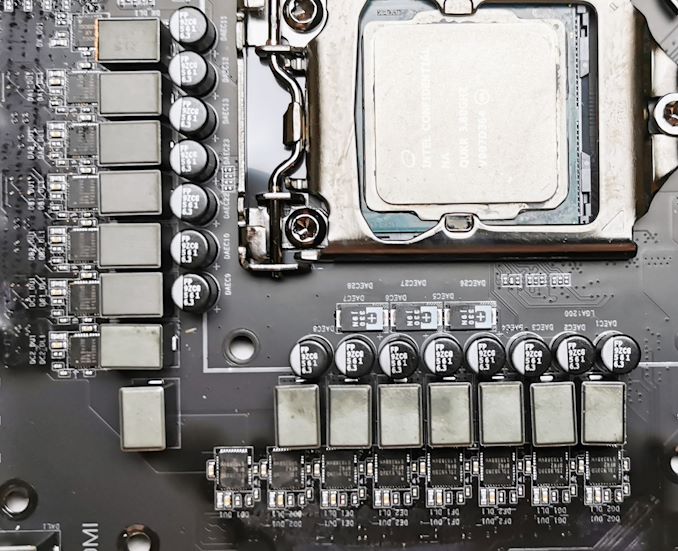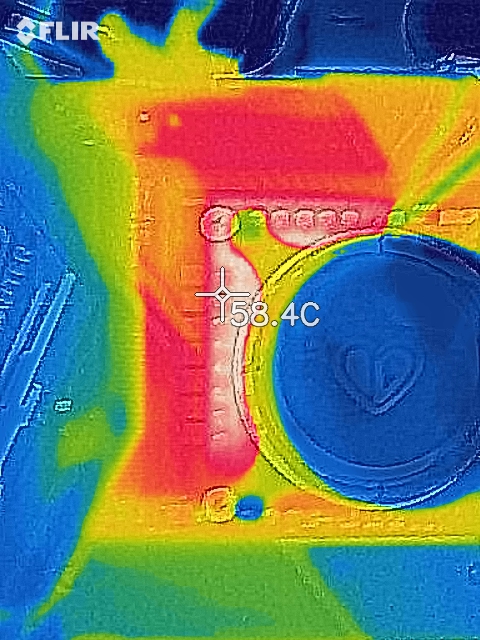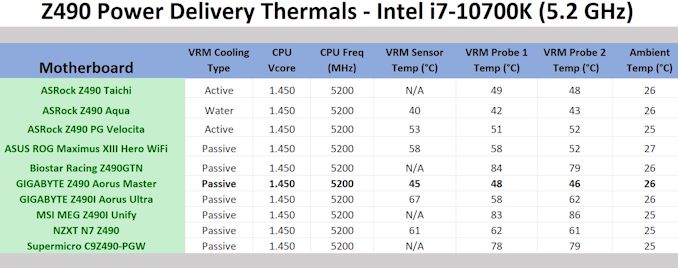GIGABYTE Z490 Aorus Master Motherboard Review: Clawing at the Competition
by Gavin Bonshor on January 7, 2021 8:00 AM EST- Posted in
- Motherboards
- Intel
- Gigabyte
- ATX
- AORUS
- Z490
- Comet Lake
- LGA1200
- Z490 Aorus Master
Power Delivery Thermal Analysis
A lot more focus has been put onto power delivery specifications and capabilities, not just by manufacturers, but as a result of users demands. In addition to the extra power benefits from things like overclocking, more efficient designs in power deliveries and cooling solutions aim to bring temperatures down. Although this isn't something most users ever need to worry about, certain enthusiasts are bringing more focus onto each boards power delivery. The more premium models tend to include bigger and higher-grade power deliveries, with bigger and more intricate heatsink designs, with some even providing water blocks on ranges such as the ASUS ROG Maximus Formula series.
 The doubled 7+1 power delivery on the GIGABYTE Z490 Aorus Master
The doubled 7+1 power delivery on the GIGABYTE Z490 Aorus Master
Testing Methodology
Our method of testing out if the power delivery and its heatsink are effective at dissipating heat, is by running an intensely heavy CPU workload for a prolonged method of time. We apply an overclock which is deemed safe and at the maximum that the silicon on our testbed processor allows. We then run the Prime95 with AVX2 enabled under a torture test for an hour at the maximum stable overclock we can which puts insane pressure on the processor. We collect our data via three different methods which include the following:
- Taking a thermal image from a birds-eye view after an hour with a Flir Pro thermal imaging camera
- Securing two probes on to the rear of the PCB, right underneath CPU VCore section of the power delivery for better parity in case a probe reports a faulty reading
- Taking a reading of the VRM temperature from the sensor reading within the HWInfo monitoring application
The reason for using three different methods is that some sensors can read inaccurate temperatures, which can give very erratic results for users looking to gauge whether an overclock is too much pressure for the power delivery handle. With using a probe on the rear, it can also show the efficiency of the power stages and heatsinks as a wide margin between the probe and sensor temperature can show that the heatsink is dissipating heat and that the design is working, or that the internal sensor is massively wrong. To ensure our probe was accurate before testing, I binned 10 and selected the most accurate (within 1c of the actual temperature) for better parity in our testing.
To recreate a real-world testing scenario, the system is built into a conventional desktop chassis which is widely available. This is to show and alleviate issues when testing on open testbeds which we have done previously, which allows natural airflow to flow over the power delivery heatsinks. It provides a better comparison for the end-user and allows us to mitigate issues where heatsinks have been designed with airflow in mind, and those that have not. The idea of a heatsink is to allow effective dissipation of heat and not act as an insulator, with much more focus from consumers over the last couple of years on power delivery componentry and performance than in previous years.
For thermal image, we use a Flir One camera as it gives a good indication of where the heat is generated around the socket area, as some designs use different configurations and an evenly spread power delivery with good components will usually generate less heat. Manufacturers who use inefficient heatsinks and cheap out on power delivery components should run hotter than those who have invested. Of course, a $700 flagship motherboard is likely to outperform a cheaper $100 model under the same testing conditions, but it is still worth testing to see which vendors are doing things correctly.
Thermal Analysis Results

We measured 58.4°C on the hottest part of the PCB around the power delivery
The GIGABYTE Z490 Aorus Master is using a 14+1 power delivery, with fourteen ISL99390 90 A power stages for the CPU VCore, and one SiC651 50 A power stage for the SoC. The power delivery is controlled by an Intersil ISL69269 PWM controller operating in a 7+1 configuration, with the fourteen ISL99390 power stages doubled up with seven ISL6617 doublers. It is cooled by a pair of heatsinks that are interconnected via a direct contact heat pipe.
In our power delivery thermal testing, the GIGABYTE Z490 Aorus Master is one of the best performers we've had installed into our motherboard test system. From our pair of K-type thermocouples, we saw temperatures of 48 and 46 degrees Celcius respectively, with a reading of 45 degrees celsius from the integrated thermal sensor on the board.
This is similar levels of performance we saw with the ASRock Z490 Taichi which is one of the board's main rivals on the market, and that model is using actively cooled heatsinks. One thing we've seen from GIGABYTE in 2020 is its ability to create an efficient power delivery, and keep them as cool as possible without the need for additional features such as cooling fans. All GIGABYTE needs now is a processor platform that doesn't spiral away into thermal oblivion.











17 Comments
View All Comments
j@cko - Thursday, January 7, 2021 - link
Screw Intel and their chipset refresh money grab tactics. They ain't gonna win back customers this way.Deicidium369 - Thursday, January 7, 2021 - link
LOL... All Businesses are there to make money PERIOD And you know that these motherboards are all old - right?Smell This - Friday, January 8, 2021 - link
Smells like Chipzillah "EOL'd" the Z490, and they are looking to clear-out inventory in the next 3 months ____ just don't see a lot of Intel CPUs moving
Mobo is $290.99 at B&H Photo $50 off with Egg Vomit Lake Combo (not a big mover)
$330 off i9-9900K Coffee Lake / $250 off i9-10850K at my MicroCenter
(no mobo) --- looks like the only thing moving is the i7-10700K at $350
Can't find a Ryzen 3900X at a decent price --- much less a 5000-series. I'm still ticked I missed it at $400
Oxford Guy - Thursday, January 7, 2021 - link
What's an Aorus?Deicidium369 - Thursday, January 7, 2021 - link
What is a Camry?quiq - Sunday, January 24, 2021 - link
a teacher carhenkhilti - Thursday, January 7, 2021 - link
VRM testing with an Core i7-10700K, really?Ian Cutress - Friday, January 8, 2021 - link
Yes, really. We don't all work in the same office and the 10900K has been used for reviews. We have editors all over the world.TheinsanegamerN - Thursday, January 7, 2021 - link
Curious why the 10900k was not used for testing? It would put greater load on those VRMeShmee - Thursday, January 7, 2021 - link
Or at least a 10850k. Those are a bit more common and a decent deal these days.